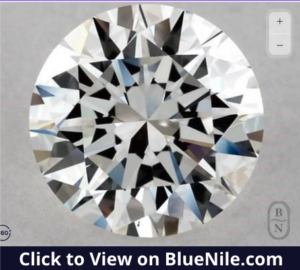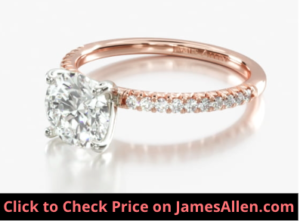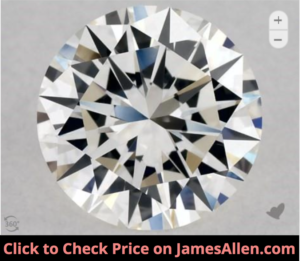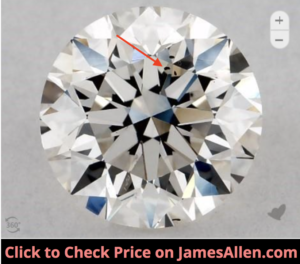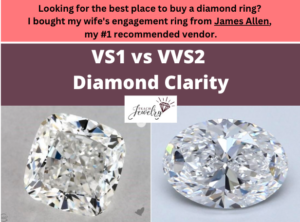
Two grades toward the middle of the GIA diamond clarity scale are VS1 (very slightly included) and VVS2 (very very slightly included).
The main difference between VS1 and VVS2 clarity is that VS1 diamonds have more inclusions that impact the diamond’s appearance, durability, and brilliance. While the two look similar to the naked eye, flaws in VVS2 diamonds are less significant.
In fact, the engagement ring diamond I bought for my wife is a VS1 round-cut diamond from James Allen.
We’ll compare VS1 versus VVS2 diamonds, including an overview of each, their three key differences, and how to decide which is right for your ring.
What is a VS1 Diamond?
VS1 diamonds have inclusions that are barely visible at 10x magnification.
The gemologist grading the diamond uses a jewelers loupe to examine its facets.
They’ll have to scan the diamond slowly, even back and forth a few times, to identify the blemishes.
To see a real example, check out this close-up image of a VS1 clarity diamond from James Allen. Rotate it 360 degrees to view how its imperfections appear at each angle.
The GIA report that’s linked to from the site notes the presence of crystals, pinpoints, and needles, but they’re difficult to spot.
VS1 sits one level below VVS2 and one above VS2 on the clarity scale. I’ve marked its position here.
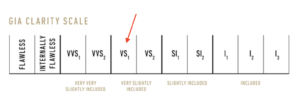
A VS1 grade isn’t referring to specific types of inclusions. Instead, it indicates its effect on the diamond’s overall appeal.
It could have any of the following inclusions:
- Twinning wisp
- Cavity
- Etch channel
- Internal graining
- Feather
- Indented naturals
For example, this one-carat diamond has crystals, pinpoints, indented naturals, and naturals but still earned a VS1 clarity grade.
Although there are four types of inclusions, each has a minimal impact and can’t be seen without magnification. Even in that close-up view, you have to search for them.
Other VS1 diamonds only have one type of inclusion. In those cases, the imperfection may have several occurrences across the diamond or be positioned in a vulnerable area like a thin girdle.
A diamond is also more likely to earn a low clarity grade if inclusions are on its table because it’s the most visible.
What is a VVS2 Diamond?
VVS2 diamonds have inclusions that are difficult to identify, even under 10x magnification.
To illustrate, the engagement ring below is set with a VVS2 diamond.
The inclusions are invisible to the naked eye. Even when I rotated the image in high-resolution, I wasn’t able to identify where they’re located.
A gemologist often has to scan back and forth with the loupe in order to find them.
Similar to VS1, VVS2 clarity doesn’t indicate the types of clarity characteristics present in the diamond.
It could have multiple occurrences of the same flaw or one instance of several kinds.
As an example, this 0.91-carat round cut diamond earned a VVS2 grade from the GIA.
Its report notes the presence of needles, pinpoints, and clouds.
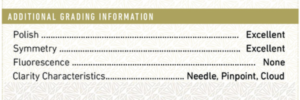
I found another example of a one-carat diamond with four inclusions, including pinpoints and indented naturals.
But you can see on the GIA report below most are consolidated into one area.
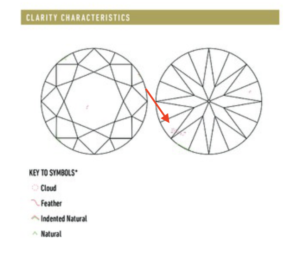
Additionally, they aren’t as visible when viewed from the top but instead are shown from the pavilion view. The only other instance is a small cloud in the center of the table, but I doubt you can spot it with your naked eye.
These qualities caused it to earn a VVS2 grade. If they were scattered across the table, it may have received a lower grade.
How are VS1 and VVS2 Diamonds Different?
1. VS1 Diamonds May Have a Higher Number of Inclusions
Most buyers want to minimize the number of imperfections in their diamond.
Flawless diamonds have no inclusions visible with magnification. It’s what distinguishes flawless clarity from VVS.
The image below is of a flawless diamond.
No matter which way you rotate the image, you won’t find any inclusions.
But as you move down the scale, inclusions that are present become higher in number, impact, or both.
In most cases, VS1 diamonds have more inclusions compared to VVS2. As additional inclusions are found in the diamond, they’re more likely to affect its performance.
For example, if all else were equal, a diamond with a few pinpoints is more valuable than one with pinpoints, cloud inclusions, and a feather.
There are exceptions to this rule.
A diamond could have only a cavity but still earn a VS1 clarity grade, while one with an etch channel, crystal, and indented natural could receive a VVS2 designation.
2. VVS2 Diamonds Sell for Higher Prices
In general, you can expect the price of a diamond to increase 10-15 percent for every position higher on the clarity scale. If you jump from one category to another, such as from I to SI or VS to VVS, expect even more of a price hike.
The best way to understand the difference in price between VVS2 and VS1 diamonds is to examine the cost of diamonds that have similar qualities across all areas except clarity.
I compiled prices for dozens of round cut diamonds from James Allen with the following traits:
- Carat weight: 0.90
- Cut: Very good
- Color: H
For diamonds with those qualities and a VS1 clarity grade, the average price is $4,706, with a range of $3,650-$5,490.
The ones that earned a VVS2 clarity grade have an average price of $4,833. The range is $4,410-$5,200.
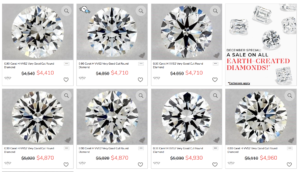
That’s a three percent average premium for a VVS2 diamond compared to VS1.
But when you compare the lowest-priced diamonds with each grade, it’s a 20 percent difference.
You can put that savings toward a larger diamond or one with a higher grade on the color and cut scale.
My recommendation is to avoid premium associated with VVS2 diamonds because a VS1 diamond often looks identical when viewed without magnification.
That was the decision I made for my wife’s diamond because I wanted to put that savings toward the carat weight and cut grade.
3. Inclusions in VS1 Diamonds Have More Impact
Inclusions impact the overall performance of a diamond, which includes its appearance, ability to withstand hits and drops, and radiate white light.
Buyers aim to avoid flaws such as black spots in their diamond, dark crystals, and white feathers because they don’t look appealing.
To illustrate, here’s a round-cut diamond with obvious black spots on its table, which I’ve highlighted below.
I wouldn’t be confident buying it based on this image because those blemishes are dark and in several locations.
It’s clearly earned its SI1 clarity grade.
Each grade down the clarity scale means the inclusions are more visible, but this generally isn’t a problem with VS1 diamonds.
Inclusions also represent vulnerable areas. The extent depends on their type, size, and position. Not all inclusions affect a diamond’s vulnerability in the same way.
The inclusions you should avoid include:
- Chips near the girdle, especially if it’s thin
- Feathers that extend far across the diamond’s table or pavilion
- Deep cavities in any location
While none of these inclusions guarantee your diamond will chip, it does increase the likelihood.
For both VS1 and VVS2 diamonds, this is a rare occurrence. There’s minimal concern about a chip.
Clarity characteristics affect a diamond’s brilliance by preventing light from properly entering and exiting its facets.
But clarity doesn’t impact brilliance as much as cut. If you want a diamond that glimmers, choose one with an excellent cut grade.
I paid the premium, and it was well worth it.
Is a VS1 or VVS2 Diamond Right For You?
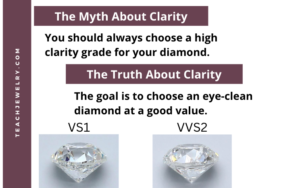
VS1 and VVS2 diamonds both have minimal issues with clarity and can serve as the perfect diamond for your ring.
Here are some tips to help decide which is right for you.
Choose a VS1 diamond if:
- You want to avoid the price premium charged for diamonds with higher clarity grades but still want the inclusions barely noticeable with magnification
- You’re choosing a diamond larger than 1.5 carats and want to ensure it’s eye-clean
Consider a VVS2 diamond if:
- You’re interested in a diamond that’s almost free of inclusions, but you don’t want to pay for one that earned a VVS1, IF, or FL grade
- You’re searching for a diamond heavier than two carats and want to ensure it looks clean to the naked eye
By pairing VS1 and VVS2 diamonds with different types of settings, you’ll land on the right one for you.

Jacob Clarke
Jacob Clarke is the founder of TeachJewelry.com.
He earned an Applied Jewelry Professional Diploma from the Gemological Institute of America (GIA) and now brings you essential information about diamonds, settings, and more.
Jacob has consulted with leading jewelry brands, and his work has been cited in Clean Origin, Diamond Nexus and industry publications.
He's also a member of the International Gem Society.
He enjoys discussing jewelry with readers, so contact him with any questions at jacob.clarke@teachjewelry.com.

